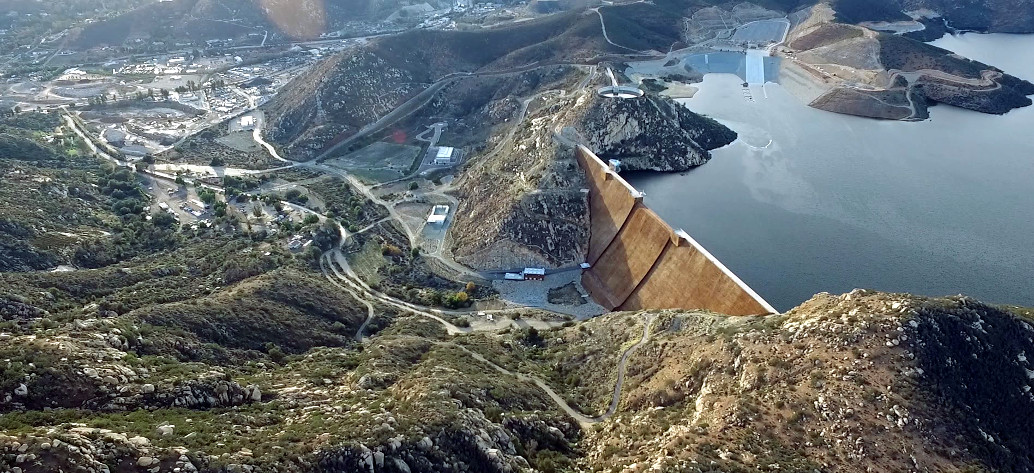Lithium-ion batteries have dominated not only conversations about the future of energy storage, but deployment in recent years. The batteries are relatively quick to install, can be scaled up or down from residential to grid-scale applications and can be sited pretty much anywhere.
Furthermore, falling costs are making such systems increasingly attractive for applications up to and including four-hour “load-shifting”, such as to accommodate California’s oversupply of mid-day power from solar and need for evening power.
The largest lithium-ion battery known to pv magazine is a 30 MW, 120 megawatt-hour (MWh) battery installed in Southern California in January, although Telsa is planning to build a 129 MWh battery in Australia. But yesterday, San Diego announced that it is looking to build an energy storage installation that could be more than 15 times as big.
The San Diego County Water Authority has issued a request for proposals (RFP) for an energy storage facility that would pump water between two reservoirs, and release this water into a hydroelectric plant when needed. The facility will be up to 500 MW in capacity, dwarfing existing battery storage systems.
This should be no surprise. While more capacity of lithium-ion batteries has been put online in recent years in the United States the global scale of pumped hydroelectric storage is far greater, with the U.S. Department of Energy reporting total capacity of at least 184 GW. This includes significant pumped hydro in Japan and European nations, as well as in the United States.
San Diego County Water Authority is developing the project jointly with the City of San Diego, and explicitly stated that a main application will be to assist with the integration of more renewable energy. Like lithium-ion batteries, pumped hydro can absorb some of the generation during the mid-day solar peak, and meet demand in the evening or overnight, with the Water Authority estimating a 5-to 8-hour storage rating.
“This potential project is an exciting and innovative opportunity to optimize our water facilities to benefit our ratepayers while helping the region as a whole meet its energy needs,” said San Diego County Water Authority Board Chair Mark Muir.
This is not the Water Authority’s first project, as it already operates a 40 MW pumped hydro storage facility at Lake Hodges.
And it is most certainly needed, as California is already experiencing both recurring negative prices and state-wide curtailment of solar during the mid-day peak. These problems are likely to be worse in San Diego, as the regional utility has the highest portion of renewable energy of the state’s three investor-owned utilities.
The Water Authority says that an initial solicitation has already drawn responses from 18 “qualified” entities. Proposals are due on September 12, and the organization expects to evaluate proposals this fall, and begin negotiations with a developer by the end of the year.
This content is protected by copyright and may not be reused. If you want to cooperate with us and would like to reuse some of our content, please contact: editors@pv-magazine.com.









I’m a big fan of pumped-storage so I wish this project all the best I really do.
Here’s what else you’d need to add to a 500MW pumped-storage with 5 to 8 hours storage reported.
You’d need 500MW (for 5 hours storage) to 800MW (for 8 hours storage) of solar and / or wind power.
You’d also need 250MW to 280 MW of back-up generators too, like biomass if you wanted renewable or gas, diesel, oil or coal if you were OK with fossil fuel.
If you put that together in the right way you ought to be able to serve 500MW peak on demand.
Check the Wind, storage and back-up system designer for more options.
http://scottish.scienceontheweb.net/Wind%20power%20storage%20back-up%20calculator.htm?peak=500
Good luck with this.
Scottish Scientist
Independent Scientific Adviser for Scotland
https://scottishscientist.wordpress.com/
* Wind, storage and back-up system designer
* Double Tidal Lagoon Baseload Scheme
* Off-Shore Electricity from Wind, Solar and Hydrogen Power
* World’s biggest-ever pumped-storage hydro-scheme, for Scotland?
* Modelling of wind and pumped-storage power
* Scotland Electricity Generation – my plan for 2020
* South America – GREAT for Renewable Energy
Pumped hydro storage of 2/3 of a day of grid power would allow solar pv to supply around 90% of the demand. Batteries can smooth frequency and voltage variation and give the hydro time to efficiently ramp up and down. As the price of batteries drops it can be part of the daily grid storage. The best combination of solar, wind, pumped hydro, batteries and waste extracted hydrocarbons in reserve generators will take a detailed study for each grid. Even now, this is an economically viable combination and it’s getting cheaper.
The two major specifications for pumped storage are power (MW) and energy capacity (MWh). Energy storage capacity can also be specified in duration. The hours of discharge at full power.
For the pumped hydro storage facility at Lake Hodges, you reported the power to be 40 MW. The second spec required is the duration in hours or the energy capacity in MWh.
Thank you!
Hello Michael,
I am clear on the ratings for energy storage, thank you.
I do not have the MWh rating for the pumped hydro storage facility at Lake Hodges, as that facility is not the main point of this article.